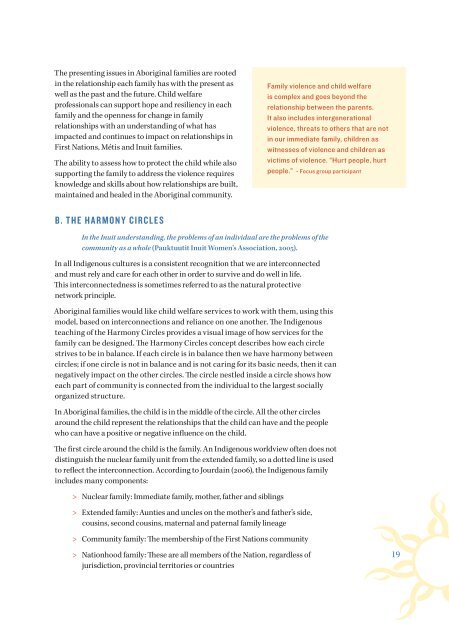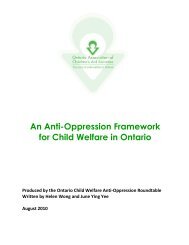English - Ontario Association of Children's Aid Societies
English - Ontario Association of Children's Aid Societies
English - Ontario Association of Children's Aid Societies
Create successful ePaper yourself
Turn your PDF publications into a flip-book with our unique Google optimized e-Paper software.
The presenting issues in Aboriginal families are rooted<br />
in the relationship each family has with the present as<br />
well as the past and the future. Child welfare<br />
pr<strong>of</strong>essionals can support hope and resiliency in each<br />
family and the openness for change in family<br />
relationships with an understanding <strong>of</strong> what has<br />
impacted and continues to impact on relationships in<br />
First Nations, Métis and Inuit families.<br />
The ability to assess how to protect the child while also<br />
supporting the family to address the violence requires<br />
knowledge and skills about how relationships are built,<br />
maintained and healed in the Aboriginal community.<br />
Family violence and child welfare<br />
is complex and goes beyond the<br />
relationship between the parents.<br />
It also includes intergenerational<br />
violence, threats to others that are not<br />
in our immediate family, children as<br />
witnesses <strong>of</strong> violence and children as<br />
victims <strong>of</strong> violence. “Hurt people, hurt<br />
people.” - Focus group participant<br />
B. THE HARMONY CIRCLES<br />
In the Inuit understanding, the problems <strong>of</strong> an individual are the problems <strong>of</strong> the<br />
community as a whole (Pauktuutit Inuit Women’s <strong>Association</strong>, 2005).<br />
In all Indigenous cultures is a consistent recognition that we are interconnected<br />
and must rely and care for each other in order to survive and do well in life.<br />
This interconnectedness is sometimes referred to as the natural protective<br />
network principle.<br />
Aboriginal families would like child welfare services to work with them, using this<br />
model, based on interconnections and reliance on one another. The Indigenous<br />
teaching <strong>of</strong> the Harmony Circles provides a visual image <strong>of</strong> how services for the<br />
family can be designed. The Harmony Circles concept describes how each circle<br />
strives to be in balance. If each circle is in balance then we have harmony between<br />
circles; if one circle is not in balance and is not caring for its basic needs, then it can<br />
negatively impact on the other circles. The circle nestled inside a circle shows how<br />
each part <strong>of</strong> community is connected from the individual to the largest socially<br />
organized structure.<br />
In Aboriginal families, the child is in the middle <strong>of</strong> the circle. All the other circles<br />
around the child represent the relationships that the child can have and the people<br />
who can have a positive or negative influence on the child.<br />
The first circle around the child is the family. An Indigenous worldview <strong>of</strong>ten does not<br />
distinguish the nuclear family unit from the extended family, so a dotted line is used<br />
to reflect the interconnection. According to Jourdain (2006), the Indigenous family<br />
includes many components:<br />
> > Nuclear family: Immediate family, mother, father and siblings<br />
> > Extended family: Aunties and uncles on the mother’s and father’s side,<br />
cousins, second cousins, maternal and paternal family lineage<br />
> > Community family: The membership <strong>of</strong> the First Nations community<br />
> > Nationhood family: These are all members <strong>of</strong> the Nation, regardless <strong>of</strong><br />
jurisdiction, provincial territories or countries<br />
19

















